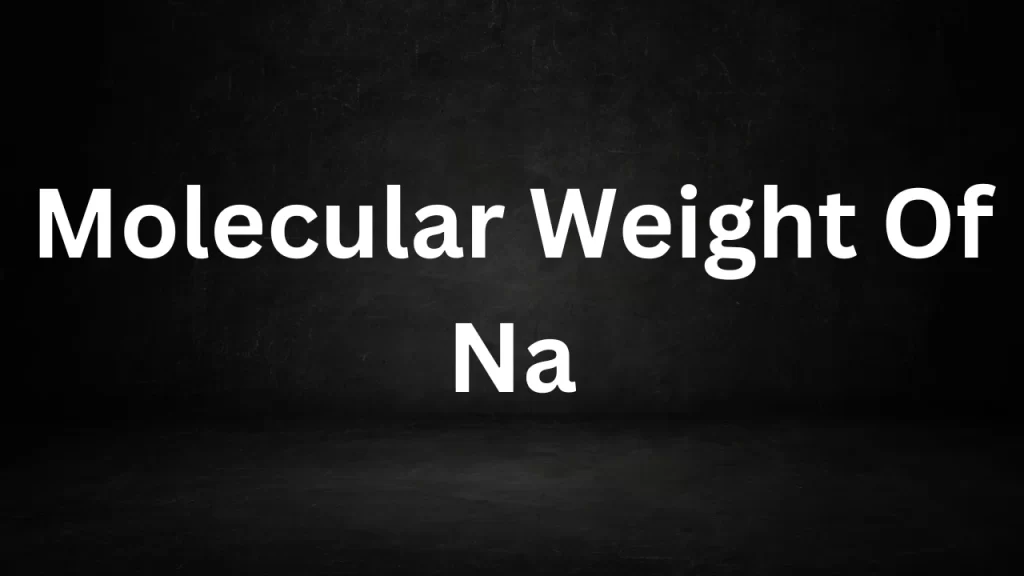Tag: na weight
Molecular Weight Of Na
Molecular Weight Of Na: Sodium, with the chemical symbol Na and atomic number 11, is an essential element found in the Earth’s crust and oceans.
In this article, we will explore the molecular weight of sodium, its significance in chemistry, and its critical role in various biological and chemical processes.

Molecular Weight Of Na
The Ubiquitous Element: Sodium
Sodium is one of the most abundant elements on Earth, primarily occurring in the form of compounds like sodium chloride (table salt) and various minerals. It is a highly reactive metal that is never found in its pure form in nature due to its extreme reactivity with moisture and oxygen.
Molecular Weight of Sodium (Na)
The molecular weight of an element, often referred to as its atomic weight or molar mass, is defined as the mass of one mole of atoms of that element, measured in grams per mole (g/mol). To calculate the molecular weight of sodium (Na), we use its atomic mass:
- Sodium (Na) has an atomic mass of approximately 22.99 g/mol.
- The molecular weight of sodium is, therefore, approximately 22.99 grams per mole.
Significance of Molecular Weight in Chemistry
The molecular weight of sodium is a fundamental value in chemistry. It is used in stoichiometry, chemical calculations, and the formulation of chemical equations. Chemists rely on molecular weights to determine the quantity of sodium and other elements involved in chemical reactions, allowing for precise measurements and accurate predictions.
Sodium’s Role in Biology and Chemistry
Sodium plays pivotal roles in both biology and chemistry:
1. Biological Significance: Sodium is an essential electrolyte in the human body, critical for various physiological processes. It including nerve function, muscle contraction, and maintaining fluid balance. Sodium ions (Na+) are actively transported in and out of cells, contributing to electrical impulses and the transmission of signals in the nervous system.
2. Chemical Reactivity: Sodium is highly reactive, particularly in the presence of water. It vigorously reacts with water to produce sodium hydroxide (NaOH) and hydrogen gas (H2). This property makes sodium valuable in various chemical processes and industries.
3. Sodium Compounds: Sodium forms compounds with a wide range of elements, such as chlorine (NaCl), forming common table salt. These compounds have diverse applications in food, industry, and medicine.
Conclusion
The molecular weight of sodium (Na), approximately 22.99 g/mol, represents the mass of one mole of sodium atoms. This seemingly simple element is indispensable in the natural world, influencing both biological and chemical processes. Sodium’s importance in maintaining human health, its reactivity in chemical reactions. Its role in various compounds underscore its significance in our daily lives and in the broader fields of chemistry and biology.
Read More
- Molecular Mass Of O2
- Molecular Mass of H2
- Molecular Mass Of NH3
- Molecular Mass Of Ch4
- Nitric Acid Molar Mass
Frequently Asked Questions (FAQs) Molecular Weight Of Na
Q1: What is the molecular weight of sodium (Na)?
A1: The molecular weight of sodium (Na) is approximately 22.99 grams per mole (g/mol).
Q2: Why is the molecular weight of sodium important in chemistry?
A2: The molecular weight of sodium is important because it allows chemists to determine the mass of one mole of sodium atoms. Which is crucial for stoichiometry, chemical calculations, and the formulation of chemical reactions. It helps in understanding the quantity of sodium involved in various chemical processes.
Q3: Is sodium always found in compounds rather than in its pure form in nature?
A3: Yes, sodium is highly reactive with moisture and oxygen, so it is never found in its pure form in nature. Instead, it is typically found in the form of compounds, such as sodium chloride (table salt), sodium carbonate, and various minerals.
Q4: What is the significance of sodium in biology?
A4: Sodium is an essential element in biology, playing a crucial role in nerve function, muscle contraction, and maintaining fluid balance in the human body. Sodium ions (Na+) are involved in transmitting electrical signals in the nervous system.
Q5: How is sodium used in chemistry and industry?
A5: Sodium’s reactivity makes it valuable in various chemical processes and industries. It is used in the production of sodium hydroxide (NaOH), which is a key ingredient in the manufacture of soap, paper, and textiles. Sodium also has applications in metallurgy, organic synthesis, and as a reducing agent in some chemical reactions.